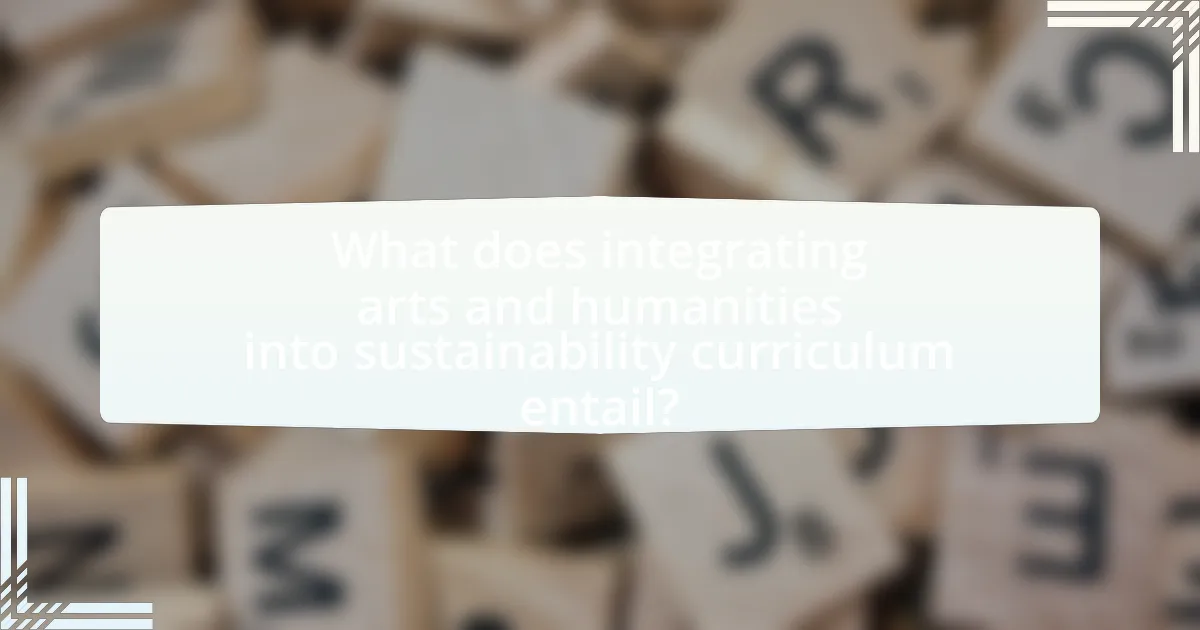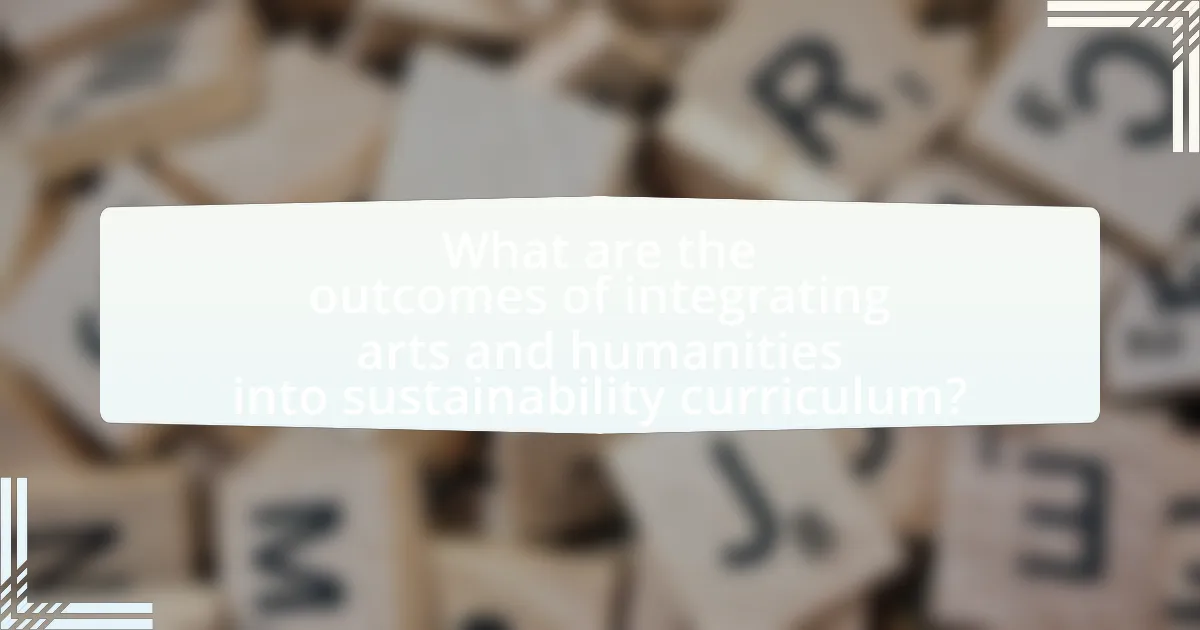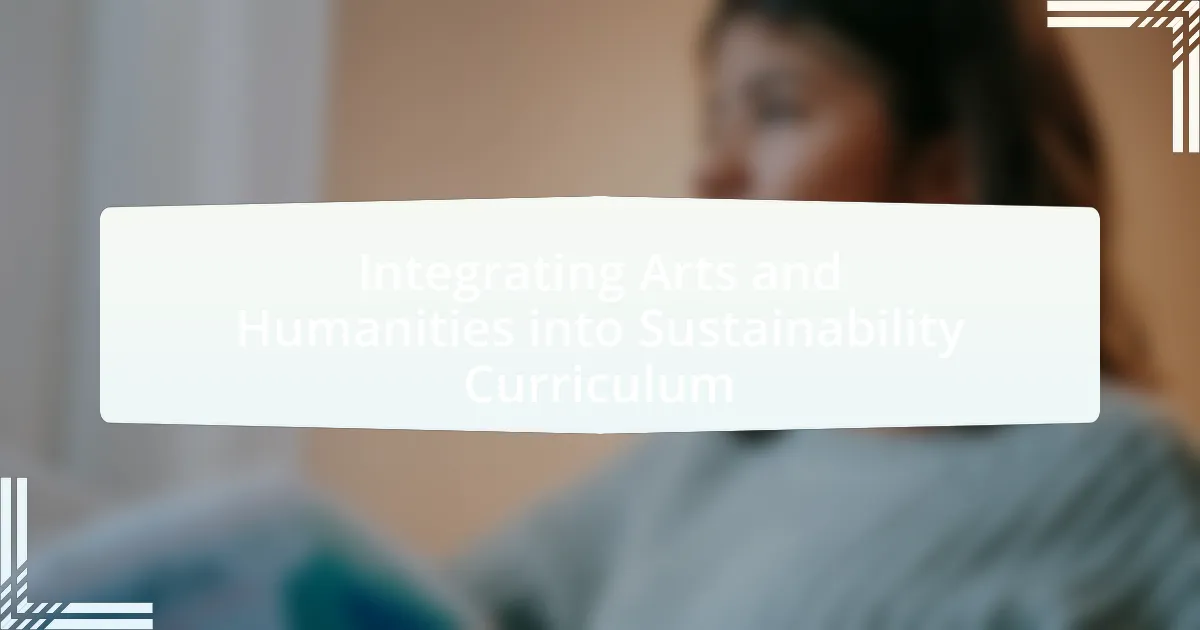Integrating arts and humanities into sustainability curriculum involves incorporating creative and critical thinking approaches to address environmental and social issues. This integration enhances students’ understanding of sustainability by emphasizing cultural, ethical, and historical perspectives, which are crucial for developing innovative solutions. The article discusses how disciplines such as environmental ethics, cultural studies, and art history contribute to sustainability education, the benefits of creative thinking in enhancing sustainability practices, and the challenges faced in this integration. It also highlights successful programs and strategies for educators to effectively implement this interdisciplinary approach, ultimately improving student engagement and learning outcomes in sustainability contexts.

What does integrating arts and humanities into sustainability curriculum entail?
Integrating arts and humanities into sustainability curriculum entails incorporating creative and critical thinking approaches to address environmental and social issues. This integration fosters a holistic understanding of sustainability by emphasizing cultural, ethical, and historical perspectives, which are essential for developing innovative solutions. For instance, studies have shown that incorporating literature and visual arts can enhance students’ engagement and empathy towards sustainability challenges, as evidenced by programs that combine environmental science with artistic expression, leading to increased awareness and community involvement.
How do arts and humanities contribute to sustainability education?
Arts and humanities contribute to sustainability education by fostering critical thinking, creativity, and cultural awareness essential for addressing complex environmental issues. Through literature, visual arts, and philosophy, these disciplines encourage individuals to explore ethical dimensions of sustainability, promoting empathy and a deeper understanding of diverse perspectives. For instance, studies show that integrating storytelling in environmental education enhances engagement and retention of sustainability concepts, as narratives can effectively convey the urgency of ecological challenges. Additionally, art projects focused on environmental themes can inspire community action and raise awareness, demonstrating the tangible impact of creative expression on sustainability initiatives.
What specific disciplines within arts and humanities are relevant to sustainability?
Disciplines within arts and humanities that are relevant to sustainability include environmental ethics, cultural studies, and art history. Environmental ethics examines the moral relationship between humans and the environment, providing frameworks for understanding sustainability. Cultural studies analyze how cultural practices and beliefs influence environmental policies and behaviors, highlighting the role of culture in sustainability efforts. Art history explores how artistic expressions reflect and shape societal attitudes towards nature and sustainability, often inspiring action and awareness. These disciplines contribute to a comprehensive understanding of sustainability by integrating ethical, cultural, and historical perspectives.
How can creative thinking from arts and humanities enhance sustainability practices?
Creative thinking from the arts and humanities can enhance sustainability practices by fostering innovative problem-solving and promoting a deeper understanding of cultural and ethical dimensions of sustainability. This approach encourages individuals to envision alternative futures and develop solutions that are not solely based on scientific or technical perspectives. For instance, interdisciplinary projects that combine artistic expression with environmental themes can raise awareness and inspire community engagement, as seen in initiatives like the “Art for the Earth” program, which uses visual arts to communicate ecological issues. Furthermore, studies have shown that integrating storytelling and narrative techniques from the humanities can effectively convey complex sustainability concepts, making them more relatable and actionable for diverse audiences.
Why is it important to include arts and humanities in sustainability curriculum?
Including arts and humanities in sustainability curriculum is important because they foster critical thinking, creativity, and cultural awareness essential for addressing complex sustainability challenges. Arts and humanities provide diverse perspectives that enhance understanding of social, ethical, and historical contexts related to sustainability issues. For instance, studies show that integrating these disciplines can improve students’ ability to engage with and communicate about sustainability topics effectively, as evidenced by programs that have successfully combined environmental science with artistic expression, leading to increased community engagement and awareness.
What are the potential impacts on student engagement and understanding?
Integrating arts and humanities into the sustainability curriculum significantly enhances student engagement and understanding. This integration fosters critical thinking and creativity, allowing students to connect complex sustainability issues with cultural and ethical dimensions. Research indicates that students exposed to interdisciplinary approaches demonstrate higher levels of motivation and retention of knowledge, as evidenced by a study published in the Journal of Environmental Education Research, which found that students engaged in arts-based projects showed a 30% increase in their understanding of sustainability concepts compared to traditional methods. Thus, the incorporation of arts and humanities not only enriches the learning experience but also deepens students’ comprehension of sustainability challenges.
How does this integration promote interdisciplinary learning?
Integrating arts and humanities into the sustainability curriculum promotes interdisciplinary learning by fostering critical thinking and creativity, which are essential for addressing complex sustainability challenges. This integration encourages students to explore diverse perspectives and methodologies, bridging the gap between scientific inquiry and humanistic understanding. For instance, a study by the American Association of Colleges and Universities highlights that interdisciplinary approaches enhance problem-solving skills and promote a holistic understanding of issues, as students learn to synthesize knowledge from various fields. This collaborative learning environment not only enriches students’ educational experiences but also prepares them for real-world applications in sustainability.
What challenges exist in integrating arts and humanities into sustainability curriculum?
Integrating arts and humanities into sustainability curriculum faces several challenges, primarily including a lack of interdisciplinary collaboration, insufficient funding, and differing pedagogical approaches. The absence of collaboration between disciplines often leads to fragmented curricula that do not fully address the complexities of sustainability issues. Additionally, funding constraints can limit the resources available for developing innovative programs that incorporate arts and humanities perspectives. Furthermore, the traditional focus on scientific and technical aspects of sustainability can overshadow the value of creative and critical thinking fostered by the arts and humanities, making it difficult to achieve a balanced educational approach. These challenges hinder the effective integration of diverse perspectives necessary for a comprehensive understanding of sustainability.
What are common misconceptions about the role of arts and humanities in sustainability?
Common misconceptions about the role of arts and humanities in sustainability include the belief that these fields are irrelevant to environmental issues and that they lack practical applications. In reality, arts and humanities contribute significantly to sustainability by fostering critical thinking, cultural awareness, and ethical considerations, which are essential for addressing complex environmental challenges. For instance, studies have shown that narratives and artistic expressions can effectively communicate sustainability concepts and engage diverse audiences, thereby promoting behavioral change and community involvement.
How can educators overcome resistance to this integration?
Educators can overcome resistance to integrating arts and humanities into the sustainability curriculum by actively engaging stakeholders through collaborative workshops and discussions. These initiatives foster a shared understanding of the value that arts and humanities bring to sustainability education, such as enhancing critical thinking and creativity. Research indicates that interdisciplinary approaches can lead to more effective learning outcomes, as evidenced by a study published in the Journal of Sustainability Education, which found that students exposed to integrated curricula demonstrated improved problem-solving skills and greater environmental awareness. By demonstrating these benefits and involving educators, students, and community members in the process, resistance can be significantly reduced.

How can educators effectively implement this integration?
Educators can effectively implement the integration of arts and humanities into the sustainability curriculum by designing interdisciplinary projects that connect environmental issues with cultural and artistic expressions. This approach encourages students to explore sustainability through various lenses, fostering critical thinking and creativity. For instance, incorporating literature, visual arts, and performance can help students understand the social and ethical dimensions of sustainability, as evidenced by programs like the “Arts for the Earth” initiative, which has shown that such integration enhances student engagement and comprehension of complex sustainability concepts.
What strategies can be employed to blend arts and humanities with sustainability topics?
Strategies to blend arts and humanities with sustainability topics include interdisciplinary collaboration, community engagement, and the use of creative storytelling. Interdisciplinary collaboration allows artists and humanists to work alongside scientists and environmentalists, fostering innovative solutions that address sustainability challenges. Community engagement involves local populations in artistic projects that highlight environmental issues, thereby raising awareness and promoting action. Creative storytelling, through mediums such as literature, visual arts, and performance, can effectively communicate complex sustainability concepts, making them accessible and relatable to diverse audiences. These strategies have been shown to enhance understanding and inspire action towards sustainability goals.
How can project-based learning facilitate this integration?
Project-based learning facilitates the integration of arts and humanities into the sustainability curriculum by providing students with hands-on, real-world experiences that connect theoretical knowledge to practical application. This approach encourages collaboration, critical thinking, and creativity, which are essential for addressing complex sustainability challenges. For instance, a study by Thomas Markham in “Project Based Learning Handbook” highlights that project-based learning enhances student engagement and retention of knowledge, making it easier for learners to grasp interdisciplinary concepts. By engaging in projects that require artistic expression and humanistic inquiry, students can explore sustainability issues from multiple perspectives, fostering a deeper understanding of the interconnectedness of these fields.
What role do collaborative partnerships play in enhancing curriculum?
Collaborative partnerships play a crucial role in enhancing curriculum by fostering interdisciplinary approaches that integrate diverse perspectives and expertise. These partnerships enable educational institutions to incorporate real-world experiences and resources, enriching the learning environment. For instance, collaboration between schools and local organizations can provide students with hands-on projects that connect theoretical knowledge to practical applications, particularly in fields like sustainability. Research indicates that such partnerships can lead to improved student engagement and learning outcomes, as they allow for the incorporation of varied teaching methods and materials that reflect the complexities of real-world issues.
What resources are available for educators looking to integrate these fields?
Educators looking to integrate arts and humanities into sustainability curriculum can access various resources, including interdisciplinary teaching guides, online courses, and collaborative networks. For instance, the National Endowment for the Arts provides resources that highlight the role of arts in environmental awareness and sustainability. Additionally, platforms like Coursera and edX offer courses specifically designed to bridge these fields, such as “Sustainable Development: The Post-Capitalist Order” which incorporates humanities perspectives. Furthermore, organizations like the Association for the Advancement of Sustainability in Higher Education (AASHE) provide toolkits and case studies that demonstrate successful integration of arts and humanities in sustainability education. These resources collectively support educators in creating a more holistic and engaging curriculum.
Which organizations provide support for curriculum development in this area?
Organizations that provide support for curriculum development in integrating arts and humanities into sustainability curriculum include the National Endowment for the Arts (NEA) and the American Association of Colleges and Universities (AAC&U). The NEA offers grants and resources aimed at fostering creative approaches to sustainability education, while the AAC&U promotes innovative curriculum design that incorporates interdisciplinary perspectives, including arts and humanities, to enhance sustainability learning. These organizations are recognized for their commitment to advancing educational practices that bridge these fields, thereby validating their role in supporting curriculum development in this area.
What types of materials and tools can assist in this integration?
Materials and tools that can assist in integrating arts and humanities into sustainability curriculum include interdisciplinary textbooks, digital media platforms, and collaborative project frameworks. Interdisciplinary textbooks provide foundational knowledge that connects sustainability concepts with artistic and humanistic perspectives, facilitating a comprehensive understanding of the subject. Digital media platforms, such as online galleries and virtual reality experiences, enable immersive learning and engagement with sustainability themes through artistic expression. Collaborative project frameworks encourage teamwork and creativity, allowing students to explore sustainability issues through various artistic mediums, thereby enhancing critical thinking and problem-solving skills. These resources collectively support a holistic approach to education that emphasizes the interconnectedness of arts, humanities, and sustainability.

What are the outcomes of integrating arts and humanities into sustainability curriculum?
Integrating arts and humanities into sustainability curriculum enhances critical thinking, creativity, and cultural awareness among students. This interdisciplinary approach fosters a deeper understanding of complex sustainability issues by encouraging students to explore ethical, social, and historical contexts. Research indicates that students exposed to arts and humanities in sustainability education demonstrate improved problem-solving skills and a greater ability to engage with diverse perspectives, as evidenced by studies such as “The Role of Arts and Humanities in Sustainability Education” published in the Journal of Sustainability Education, which highlights the positive impact of this integration on student engagement and learning outcomes.
How does this integration affect student learning outcomes?
Integrating arts and humanities into the sustainability curriculum positively affects student learning outcomes by enhancing critical thinking and creativity. This integration fosters a deeper understanding of complex sustainability issues through diverse perspectives, allowing students to engage with material in a more meaningful way. Research conducted by the National Endowment for the Arts indicates that students exposed to arts education demonstrate improved problem-solving skills and higher levels of engagement in their studies, which directly correlates with better academic performance. Furthermore, a study published in the Journal of Sustainability Education found that interdisciplinary approaches, including arts and humanities, lead to increased student motivation and retention rates, ultimately resulting in more effective learning outcomes in sustainability education.
What skills do students develop through this interdisciplinary approach?
Students develop critical thinking, creativity, collaboration, and communication skills through the interdisciplinary approach of integrating arts and humanities into the sustainability curriculum. This approach encourages students to analyze complex problems from multiple perspectives, fostering innovative solutions. For instance, engaging with artistic expressions and humanistic inquiries allows students to articulate their ideas effectively and work collaboratively on sustainability projects, enhancing their ability to address real-world challenges. Research indicates that interdisciplinary education promotes deeper understanding and retention of knowledge, as students learn to connect concepts across disciplines, thereby preparing them for diverse career paths in sustainability and beyond.
How can this integration influence students’ perspectives on sustainability issues?
Integrating arts and humanities into the sustainability curriculum can significantly enhance students’ perspectives on sustainability issues by fostering critical thinking and emotional engagement. This integration allows students to explore complex sustainability topics through diverse lenses, such as literature, visual arts, and philosophy, which can deepen their understanding and empathy towards environmental challenges. Research indicates that students exposed to interdisciplinary approaches are more likely to develop a holistic view of sustainability, recognizing the interconnectedness of social, economic, and environmental factors. For instance, a study by the National Endowment for the Arts found that arts education improves students’ ability to analyze and interpret information, which is crucial for addressing sustainability issues effectively.
What best practices should educators follow for successful integration?
Educators should prioritize interdisciplinary collaboration, active learning, and community engagement for successful integration of arts and humanities into sustainability curriculum. Interdisciplinary collaboration fosters diverse perspectives, allowing educators to combine knowledge from various fields, which enhances critical thinking and problem-solving skills among students. Active learning strategies, such as project-based learning and experiential activities, engage students in real-world sustainability challenges, making the content more relevant and impactful. Community engagement connects students with local issues and stakeholders, promoting a sense of responsibility and encouraging civic participation. Research indicates that these practices lead to deeper understanding and retention of knowledge, as evidenced by studies showing improved student outcomes in integrated curricula.
How can assessment methods be adapted to evaluate interdisciplinary learning?
Assessment methods can be adapted to evaluate interdisciplinary learning by incorporating diverse evaluation techniques that reflect the integration of multiple disciplines. For instance, project-based assessments can be utilized, allowing students to engage in real-world problems that require knowledge from various fields, such as environmental science, ethics, and social studies. This approach not only assesses students’ understanding of content but also their ability to synthesize information and apply it in practical contexts.
Additionally, rubrics can be designed to include criteria that specifically address interdisciplinary skills, such as collaboration, critical thinking, and creativity. Research indicates that interdisciplinary assessments enhance student engagement and learning outcomes, as they encourage learners to make connections across subjects (Beers, 2011, “21st Century Skills: Preparing Students for Their Future”). By using these adapted methods, educators can effectively measure the depth of interdisciplinary understanding and the application of knowledge in sustainability contexts.
What are some examples of successful programs that have integrated these fields?
Successful programs that have integrated arts and humanities into sustainability curriculum include the “Sustainable Arts in Education” initiative at Stanford University and the “Art and Sustainability” program at the University of Oregon. The Stanford initiative combines artistic practices with environmental education, fostering creativity in addressing sustainability challenges. The University of Oregon’s program emphasizes the role of art in promoting ecological awareness and community engagement, demonstrating the effectiveness of interdisciplinary approaches in sustainability education. These programs exemplify how integrating diverse fields can enhance understanding and action towards sustainability.

Leave a Reply